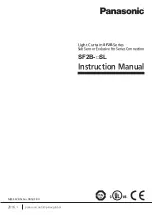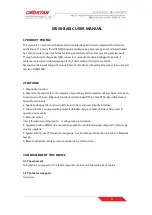
LE YB OLD DIDA CTIC GMBH
⋅
Leyboldstrasse 1
⋅
D-50354 Hürth
⋅
Phone (02233) 604-0
⋅
Telefax (02233) 604-222
⋅
e-mail: [email protected]
©
by Leybold Didactic GmbH
Printed in the Federal Republic of Germany
Technical alterations reserved
3
Operation
Set the stroboscope to the desired range using the rotary switch
4
. Following a brief self-test (approx. 2 s), the display
2
shows
the last frequency selected with knob
3
and the stroboscope
begins to flash at this frequency.
To change the flash frequency, turn knob
3
:
to change the flash rate in small steps (0.01 Hz)
– turn slowly
to change the flash rate in large steps
– turn rapidly.
To measure frequencies of periodic motions, begin with a low
frequency and increase this until you can observe a recogniza-
ble or marked position in the moving system as stationary with
respect to two (opposing) points. Then reduce the frequency by
one half and carefully adjust it until you once again obtain a
stationary image.
For rotational motions, the rotational speed can be calculated
as: 1 Hz
=
1 rps = 60 rpm.
Flash phase:
To shift the flashing point while observing a stationary image,
you can vary the blitz phase. To do this, press pushbutton
5
.
The message “PH.A” briefly appears in the display
2
, followed
by the last phase angle selected. Turn knob
3
to select the
phase angle:
to change the phase angle in small steps (0.1°)
– turn slowly
to change the phase angle in large steps
– turn rapidly
To toggle to the frequency, press pushbutton
5
again. The
message “Fr.E” briefly appears in the display
2
, followed by
the frequency.
External triggering:
To externally trigger flashes, connect signal input socket (6.2).
You can do this by connecting a voltage source, ideally a
function generator, to sockets (6.2) and (6.3) or by connecting
socket (6.1) to (6.2) using a switch or a forked light barrier (Fig.
2).
The external frequency appears in display
2
. Flashing of dis-
play
2
indicates that the applied frequency is out of the range
set using rotary switch
4
.
The device automatically switches to the external timing as
soon as a timing signal (voltage) is present. To reset the device
to internal timing (when no external signal is present), manipu-
late knob
3
; after a brief interval the last set flash frequency is
restored.
4
Replacing the flash tube
Remove the plastic window and take out the defective flash
tube. Carefully insert the spare flash tube; do not touch the flash
tube directly with your fingers, to prevent contamination of the
tube. Then remount the plastic window.
Fig. 2




















